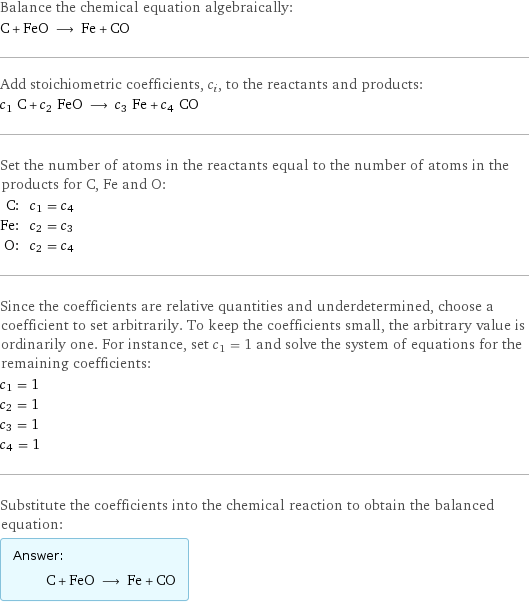Input interpretation

C (activated charcoal) + FeO (iron(II) oxide) ⟶ Fe (iron) + CO (carbon monoxide)
Balanced equation

Balance the chemical equation algebraically: C + FeO ⟶ Fe + CO Add stoichiometric coefficients, c_i, to the reactants and products: c_1 C + c_2 FeO ⟶ c_3 Fe + c_4 CO Set the number of atoms in the reactants equal to the number of atoms in the products for C, Fe and O: C: | c_1 = c_4 Fe: | c_2 = c_3 O: | c_2 = c_4 Since the coefficients are relative quantities and underdetermined, choose a coefficient to set arbitrarily. To keep the coefficients small, the arbitrary value is ordinarily one. For instance, set c_1 = 1 and solve the system of equations for the remaining coefficients: c_1 = 1 c_2 = 1 c_3 = 1 c_4 = 1 Substitute the coefficients into the chemical reaction to obtain the balanced equation: Answer: | | C + FeO ⟶ Fe + CO
Structures

+ ⟶ +
Names

activated charcoal + iron(II) oxide ⟶ iron + carbon monoxide
Equilibrium constant
![K_c = ([Fe] [CO])/([C] [FeO])](../image_source/71963b55579963043f519aa06294126f.png)
K_c = ([Fe] [CO])/([C] [FeO])
Rate of reaction
![rate = -(Δ[C])/(Δt) = -(Δ[FeO])/(Δt) = (Δ[Fe])/(Δt) = (Δ[CO])/(Δt) (assuming constant volume and no accumulation of intermediates or side products)](../image_source/05e59633b3d982c9e0e730d63c593aaa.png)
rate = -(Δ[C])/(Δt) = -(Δ[FeO])/(Δt) = (Δ[Fe])/(Δt) = (Δ[CO])/(Δt) (assuming constant volume and no accumulation of intermediates or side products)
Chemical names and formulas

| activated charcoal | iron(II) oxide | iron | carbon monoxide formula | C | FeO | Fe | CO name | activated charcoal | iron(II) oxide | iron | carbon monoxide IUPAC name | carbon | oxoiron | iron | carbon monoxide
Substance properties

| activated charcoal | iron(II) oxide | iron | carbon monoxide molar mass | 12.011 g/mol | 71.844 g/mol | 55.845 g/mol | 28.01 g/mol phase | solid (at STP) | solid (at STP) | solid (at STP) | gas (at STP) melting point | 3550 °C | 1360 °C | 1535 °C | -205 °C boiling point | 4027 °C | | 2750 °C | -191.5 °C density | 2.26 g/cm^3 | 5.7 g/cm^3 | 7.874 g/cm^3 | 0.001145 g/cm^3 (at 25 °C) solubility in water | insoluble | insoluble | insoluble | dynamic viscosity | | | | 1.772×10^-5 Pa s (at 25 °C) odor | | | | odorless
Units
